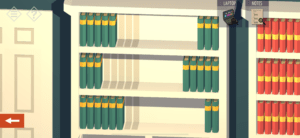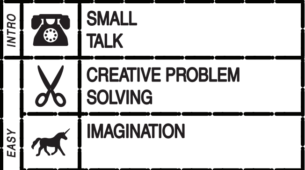
For this critical play I decided to play Tiny Rooms Story Mystery by Kiary Games Ltd. This is a mobile app game that is made for fans of escape rooms, mysteries, and more. The game itself is a series of levels that are each escape rooms set within a town where the main character’s father lives and is trying to leave clues to help the main character find them. These rooms are often full houses or buildings, and even include outdoor areas. The game uses isometric perspective orthree-quarter view to display the 3-d simple world. You are able to swipe directions to turn the map and can see everything in the game from the front, sides, and behind, making for a game that literally leaves no stone unturned.

The game is able to weave narrative into the mystery by using things related to the story within the escape room puzzles. For instance, the game is all about helping your father, and you do so by visiting the rooms/houses/buildings that are relevant to him, allowing the architecture of his house (in the second level) to play a role and give us an understanding of what our father is like and what he or others may be hiding. The game’s mechanics are very simple, you can swipe left and right to turn the room you are currently in, letting you see everything from every angle. You can also tap on essentially everything, and it will either collect that thing into your inventory (like a key or a book), allow you to interact with it (like a knob or a switch), or it will tell you that there is nothing to be learned from that object, these three mechanics create for a very easy game to learn as you can click around on everything and not leave anything behind. However,the game balances this “button-mashing” ease by requiring you to think and use your brain with the puzzle-solving-flow dynamic. For instance, in the first episode, we click around into a cabinet and find the password for the computer, but when we try it, it doesn’t work.  We then click into a different cabinet and find a file that has four squares with arrows pointing between them. We used the mechanics of the game to somewhat easily click around and find these things, and now get to use the puzzle dynamics to tell ourselves that the corresponding squares and arrows should be how we move the password numbers around, and sure enough, it let us get into the computer! So the combined effects of the easy mechanics with the more challenging overall dynamic, as well as the simple/elegant 3-d art of very personal and personable rooms creates a
We then click into a different cabinet and find a file that has four squares with arrows pointing between them. We used the mechanics of the game to somewhat easily click around and find these things, and now get to use the puzzle dynamics to tell ourselves that the corresponding squares and arrows should be how we move the password numbers around, and sure enough, it let us get into the computer! So the combined effects of the easy mechanics with the more challenging overall dynamic, as well as the simple/elegant 3-d art of very personal and personable rooms creates a narrative, challenge, and discovery aesthetic. This game was truly very fun, and it has the perfect story-to-gameplay ratio, ensuring that it is a game that’s mechanic driven that tells a good story, and not a story that uses some poor mechanics to disguise itself as a game. The first two episodes took me roughly 30 minutes, but I have continued playing just on my own time and now am on the fifth level, demonstrating that the game is clearly fun as I have played and played past the assignment’s requirements. (Also, bonus points for the game being free – love to see that).
narrative, challenge, and discovery aesthetic. This game was truly very fun, and it has the perfect story-to-gameplay ratio, ensuring that it is a game that’s mechanic driven that tells a good story, and not a story that uses some poor mechanics to disguise itself as a game. The first two episodes took me roughly 30 minutes, but I have continued playing just on my own time and now am on the fifth level, demonstrating that the game is clearly fun as I have played and played past the assignment’s requirements. (Also, bonus points for the game being free – love to see that).
 While I loved this game and would highly recommend it to all my friends, it’s clear that there can be some accessibility issues related to vision. Some of the clues that you need to find, like keys, or a patch on the back of a couch, or a sticky note can be very small and not clear at all. Thankfully if you click around enough you’ll eventually run into something of importance, but it can be challenging, even for me who has decent vision with contacts in, to see the minute details that are crucial to the game; missing one item in this game isn’t an accident that can be looked over, if you miss one single thing, the rest of the game is screwed. Beyond just the sizing of things, some of the clues can be difficult for colorblind people as well. I played this game with my friend Shane de Flores after he say me playing, and he could not understand the part of the second level where there were book cases. I told him to just sort the books how they are in the photos, but he said that he had and they weren’t working. Only when I actually looked at his screen did I see that the red and green books hadbeen misplaced, but he genuinely couldn’t tell. To have a clue that relies on colors as much as this one does, there ought to be a better color scheme or a way to differentiate the books beyond just color. As far as the colorblind issue, this can be easily fixed by adding special characters to these books and not relying on pure color to differentiate. For the issue of small items and difficult viewing them, it could help to really contrast them with light and dark patterns, or making them bigger, or adding some image-to-speech option so that players can hear all the options they have in front of them.
While I loved this game and would highly recommend it to all my friends, it’s clear that there can be some accessibility issues related to vision. Some of the clues that you need to find, like keys, or a patch on the back of a couch, or a sticky note can be very small and not clear at all. Thankfully if you click around enough you’ll eventually run into something of importance, but it can be challenging, even for me who has decent vision with contacts in, to see the minute details that are crucial to the game; missing one item in this game isn’t an accident that can be looked over, if you miss one single thing, the rest of the game is screwed. Beyond just the sizing of things, some of the clues can be difficult for colorblind people as well. I played this game with my friend Shane de Flores after he say me playing, and he could not understand the part of the second level where there were book cases. I told him to just sort the books how they are in the photos, but he said that he had and they weren’t working. Only when I actually looked at his screen did I see that the red and green books hadbeen misplaced, but he genuinely couldn’t tell. To have a clue that relies on colors as much as this one does, there ought to be a better color scheme or a way to differentiate the books beyond just color. As far as the colorblind issue, this can be easily fixed by adding special characters to these books and not relying on pure color to differentiate. For the issue of small items and difficult viewing them, it could help to really contrast them with light and dark patterns, or making them bigger, or adding some image-to-speech option so that players can hear all the options they have in front of them.


